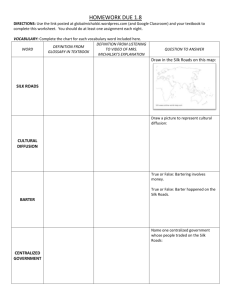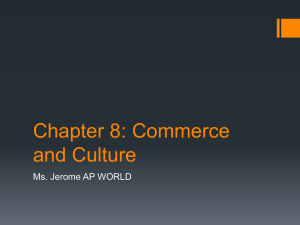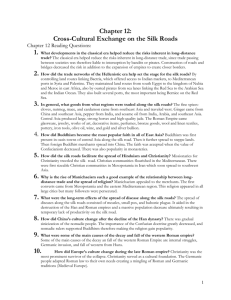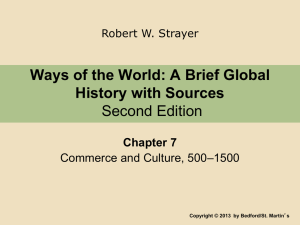Chapter 8
advertisement
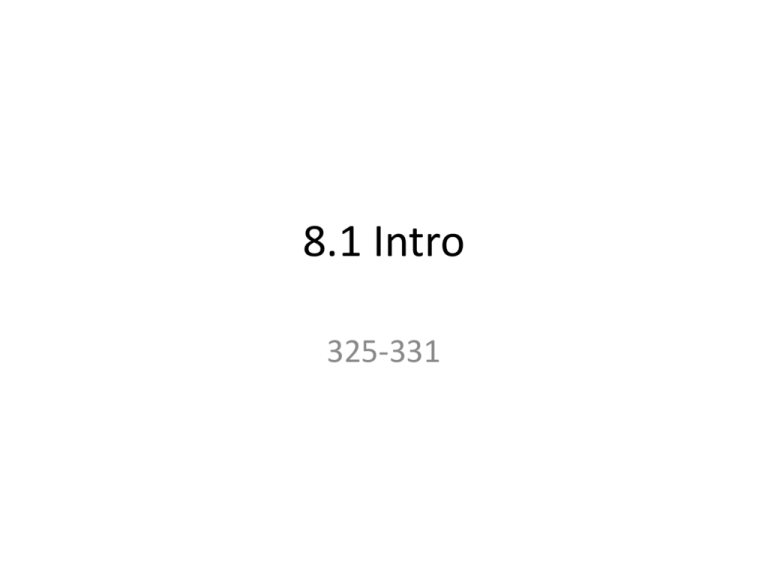
8.1 Intro 325-331 0 What is Unit 3? • Begins at the end of the classical era • Ends around 1450 when European exploration begins • Can be called – Post-classical – Medieval – Middle (Eurocentric) • We call it “third-wave” civilizations – – – – – Islam is biggest Byzantium takes Eastern Roman Empire Huge dynasties in China Aztecs and Incas in Americas Catholic Church grows power in Western Europe 1. While culturally unique, features among each of the new “third-wave civilizations” point to what distinct patterns of development? • States, cities, class and gender inequalities • Borrowed from established civilizations • Started after 500 CE • pp. 326-327 1.A What is the most important common thread among third wave civilizations? • Tons of interaction with others – By trade – By military conflict – By cosmopolitan regions (miniglobalizations) • Large empires ruled by pastoral people who ruled agricultural people – Arabs, Mongols, Aztecs 2. Why is Islam seen as the most influential of the new “third-wave civilizations?” • Included Egypt, Mesopotamia, India, most of Northern Africa, Spain. • Came closer than any had ever come to uniting all mankind under its ideals. • p. 326 1B. Europe (Byzantine Empire/Holy Roman Empire) • The Roman Empire splits • Byzantine Empire - Eastern half of the Roman Empire that lived on – Stays really centralized, unified – Stays strong for 1000 years until Muslims take Constantinople in 1453 • Renamed it Istanbul • Holy Roman Empire – Not holy, not Roman, not an empire – Decentralized – Becomes the feudal system (small kingdoms) (dippin’ dots) 1C. China/India/West Africa • China - Sui, Tang, Song – Middle ages dynasties – Go back to Confucian traditions • India – stays decentralized – Keeps caste – Some Muslims take parts of India • West Africa – becomes Muslim – Islam really spread by trade 1D. Western Hemisphere? • Aztecs in Mexico • Inca in Peru (Andes, South America) • Both are very bureaucratic/elaborate 3. Why were political systems important for trade? • State’s size and stability encouraged travelers and traders. • Wealth from taxes led to more power for the state. • First Rome and China made trade safe. (classical) • 600s 700s - Byzantine, Tang and Abbasid made trade safe. • 1200s – Mongols controlled almost all of the Silk Roads. • p. 328; 334 3.A. What was trade like in third wave civilizations? • Indirect • Network across vast land • Changed things like – Consumption – Religious ideas – Crops and livestock availability – Made cultures less self-sufficient – Made traders a social group 3B. What’s the deal with inner and outer Eurasia? • Outer – warm, good water and soil – China, India, Mediterranean • Inner – harsh, dry, pastoral – Eastern Russia, Central Asia 4. What did large-scale empires and long-distance trade facilitate? • The spread of ideas, technologies, food crops, and germs far beyond their points of origin. • Pp. 334-335 8.1 Quiz A 1. The civilizations that come during this unit have been referred to as _______-wave civilizations. 2. Name one of the two major civilizations that existed in the Western hemisphere during this time period. 3. On which continent was most of the Byzantine Empire? 8.1 Quiz B 1. Which of the third-wave civilizations came the closest to unifying most of the world under one umbrella? 2. On which continent was most of the Byzantine Empire? 3. Name one of the two major civilizations that existed in the Western hemisphere during this time period. 8.2 Silk Road/Disease 5. What specifically did the following regions or peoples diffuse through trade? • China: the technology of manufacturing raw silk • India: crystallized sugar, the concept of zero, cotton textiles • Arabs: Islam • The Americas/Mesoamerica: corn • Eurasia and North Africa: disease—the plague • p. 329 6. How were goods transported along the Silk Roads to sustain the networks of exchange among its diverse people? • Camel caravans • Through deserts and oases • Silk was used as currency in Asia – Symbol of high status • Not made in W. Europe until 1100s • p. 336 7. Why did Han China extend its authority westward? • Wanted to control the Xiongnu (nomads) and get “heavenly horses” for their military. • Heavenly horses – well trained, easy to ride, some said they sweat blood • p. 336 8. What made silk such a highly desired commodity across Eurasia? • Silk symbolized luxury. • China held a monopoly on silk-producing technology. • Cotton textiles from India was great in the Roman Empire as well • p. 337 9. How did the impact of the long-distance trade of silk economically and socially affect the Chinese peasants? • Some stopped growing food crops and made silk, paper, porcelain and iron tools. • This is an example of long-distance trade trickling down to common farmers. • p. 338 10. Why did Buddhism appeal to the merchants along the Silk Roads? • It was for all people, not just Brahmin and higher castes. • Merchants were lower to middle class at best. • In China, it was the religion of foreign traders and rulers. • p. 338 11. In what way did Buddhism pick up elements of other cultures along the Silk Roads? • Monasteries became more secular. – Some monasteries became rich from wealthy merchants’ gifts. – Murals of parties and musicians • Shifted to Mahayana, which reflected influence from monotheistic religions. – Buddha became a god. – Idea of heaven. • Some statues of Buddha show Greek influences from Alexander’s conquests • Gods from other faiths were incorporated into Mahayana Buddhism. • pp. 339-340 12. After the spread of the Black Death to Europe, what were two economic consequences of the disease? • Less tenant farmers and urban workers could demand higher wages b/c there are less of them. • Landowners lost money because demand for grain dropped. • 340-341 12A Before the Black Plague, what other diseases were spread? • Unknown epidemic in 500BCE Athens from sea exploration • Han and Roman smallpox and measles – Increased importance of Christianity and Buddhism as compassion during times of suffering 12B Teach me more about the Black Plague! • Thanks to the Mongols control of Eurasia, it spread. • May have been anthrax, the plague or a mix of goodness • 1/3 of Europe killed (How’s that for westerncentrism?) – Similar toll in Muslim world and China • Gave Europeans a secret weapons when exploring in 1500s 13. Why did the exchange of diseases give Europeans a certain advantage? • Exposure over time had provided them with some immunity to Eurasian diseases. • p. 341 8.1 Quiz A 1. Which major city in the Byzantine Empire lost more than 10,000 people per day for forty days from the bubonic plague? 2. People outside of China wanted silk because it was ______________. 3. The spread of certain diseases throughout Europe gave them an advantage later on because they built built up a(n) ____________. 8.1 Quiz B 1. Which Greek city-state was afflicted by a new disease that probably come by sea from Egypt? 2. The Silk Roads prospered most when large __________ provided protection for traders. 3. A lot of the trade in Eurasia was called “_________ trade” because goods were passed down the line, changing hands many times before reaching its final destination. 8.3 Sea Roads 341-348 14A How did sea trade begin? • Lots of trade on Mediterranean by 1000CE centered in Venice • Mediterranean linked Europe to Indian Ocean through rivers in Egypt • Ancient Indus writing may have influenced cuneiform from Mesopotamia • Egyptians and Phonecians traded on Red Sea 14. How did the transportation operation of the Indian Ocean trading network differ from that of the Silk Roads? • Costs were lower than on land – Ships held more and heavier cargo • textiles, pepper, timber, rice, sugar, wheat – Led to shipment of bulk goods • Silk Roads were only for luxury goods • Sea Roads relied on monsoon wind currents. • India was center of the Sea Roads, but not the Silk Roads. • 341-342 15. Why did the tempo of Indian Ocean commerce pick up in the era of classical civilizations? • Sailors learned how to ride the monsoons. • p. 343 16. What region became the center (fulcrum) of the Indian Ocean commercial network? • India. – Had goods from east and west. – Lots of port cities. • Trading with Southeast Asia by 100CE and all around the Indian Ocean as far as Egypt. • pp. 343-344 • • • • 17. In what ways did China contribute to the growth of trade in the Indian Ocean between 500 and 1500 C.E.? Tang and Song dynasties encouraged sea trade. Big economy led China to send tons of products out for trade. Larger ships and magnetic compass added to growth. p. 344 18. What other changes occurred during the flourishing of Indian Ocean commerce after the rise of Islam in the 7th century? • Arab Empire—Brought together many different cultures and economies into one political system. This made trade very easy for Arabs. • Middle East—Middle Eastern gold and silver went to southern India to purchase pepper, pearls, textiles, and gemstones. • Muslim merchants—Islam loved merchants. (Muhammad was a merchant) Muslim culture spread far and everyone was part of the same culture even if they were far apart. • Mesopotamia/East Africa—Using wasteland in Mesopotamia to cultivate sugar and dates brought thousands of slaves there from East Africa for plantations and salt mines in terrible conditions. • p. 344 19. What was the importance of Srivijaya? • Malay Peninsula was choke-point between China and India trade. • One kingdom, Srivijaya charged taxes for ships to use the Straits of Malacca – Had spices, gold and resources to sell sailors • Gained much money, power and new military brought security to the area. • p. 345 19A What other Southeast Asian places were influenced by trade? • Burma – Ankor Wat – huge Buddhist temple – First Hindu – Then Buddhist 21. What were the economic and cultural roles of the Swahili civilization in the world of Indian Ocean trade? • Economically, cities took goods from African interior and exchanged them on the coast for foreign products like porcelain, silk and rugs – Major port cities on the coast • Culturally, many ruling families of Swahili cities claimed Arab or Persian descent to show prestige – Coast became Muslim, interior stayed African • Politically, they were competing city-states like Greece – Focused on trade and profit • p. 347 8.3 Quiz A 1. This civilization was on the east coast of Africa and became increasingly Muslim. It was where much of the Indian Ocean trade took place. 2. What religion spread mainly to the eastern part of the Indian Ocean by traders? 3. How did Srivijaya become so rich? 8.3 Quiz B 1. What religion was represented by the huge monument of Borobudur in Indonesia? 2. Whereas the Silk Roads mainly traded precious items, the Sea Roads mainly traded _______ items. 3. The Sea Roads took place mainly on which body of water? 8.4 Sand Roads and American Roads 22. Trans-African trade was rooted in environmental variation. For instance, • TRADE HAPPENED IN AFR B/C AFR’S ENVIORNMENT WAS SO DIFFERENT • Sahara – copper, gold and salt • The savanna grasslands immediately south of the Sahara produced—grain crops like millet and sorghum. • The forest areas farther south had yams/ • pp. 348-349 23. What changes did trans-Saharan trade bring to West Africa? • The camel brought the biggest change – 10 days w/o water • Led to the exchange of mined gold from Sahara out into the rest of the world • Muslims traded slaves along the Sahara – Most from non-Muslim areas (West Africa) Some white women from Eastern Mediterranean • Sudanic states develop big urban trading centers. – Jenne-jeno, Timbuktu, Gao all in modern-day Mali • Beads, iron tools, cotton textiles • pp. 350-351) More on West African Trade • Camel caravans – 5000 camels and hundreds of ppl • Gold trading leads to strong empires in West Africa that grew by taxing merchants – Ghana first and then Mali 24. Compare some factors that inhibited the development of long-distance exchange networks in the Americas, as opposed to Eurasia. • Aztecs and Incas probably didn’t know the other existed • Less interactions because no horses, donkeys or camels. • No wheeled vehicles or ocean-going ships • Geography – Bottleneck of Panama covered in rainforest – North/south orientation – made new agriculture adapt to new climates when migrating – Eurasia’s east/west orientation made agricultural diffusion easier • pp. 351-352 24A What was trade like in the Americas? • Loose interactive web in North America – Cahokia, Chaco, others traded indirectly with Caribbean and others – It was a very WEAK connection • Major trade network in Mesoamerica – Maya and Teotihuacan traded by land – Maya had dugout canoes to trade by sea – Aztecs had professional merchants 24B Cahokia • Near St. Louis on the Mississippi River – Part of the “Mound Builders” • Right in the middle of the loose network of American trade • Archaeologists found – – – – Shells from Atlantic coast Buffalo hides from Great Plains Obsidian from Rocky Mountains Mica (shiny rock) from Appalachians • This proves that there was some long distance trade 26. What were Inca roads used for? • Transporting state controlled goods by pack animals or messages by foot • 2,000 inns where travelers could get food and shelter • Relay system for messages could cover 150 miles in one day. • p. 353 27. Why did the Andean Inca Empire largely control trade, not allowing a professional merchant class to emerge? • Incan trade was state-run. • No free market (capitalism) like Aztecs. • p. 354 27A How is modern trade different from premodern trade? • Premodern was mainly for self consumption – Very little was actually traded – Modern trade was often relay-based • • • • Premodern had fewer wageworkers Premodern was mainly luxury goods Premodern was much more local Premodern was much more equal among trading societies 8.4 Quiz A 1. Which American empire kept government control of most of the trading there? 2. List two specific items that were traded on the Sand Roads. 3. A lot of the trading on the Sand Roads was done using __________ caravans. 8.4 Quiz B 1. The introduction of which animal changed the Trans-Sahara trade networks the most? 2. The “blue men” that were in Ireland were living there because they were __________. 3. Name one of the two major empires in Western Africa during this time period. Both of them were major trading empires. 8.5 Docs Chinese Buddhist, Ibn Batutta and Marco Polo A Chinese Buddhist in India • Traveled there for clarification of Buddhism – Muslims go to Mecca, Christians to Jerusalem • Visits the Bodhi Tree, cries • Visits a monastery/university – Monks studied math and science just like they mediated – Major places of learning A Chinese Buddhist in India Towns and Villages • Walls around the cities and each individual house • Untouchables live outside the city – Butchers, fishers, executioners Buddhist Studies • Different sects in India vary in their worship • Great (Mahayana) and Little (Theravada) vehicles live in different parts of town • The more you know about Buddhism, the more stuff you get (paid for by tithe to the monastery) • If you make a mistake, you’re thrown in a ditch. Yay. Caste and Marriage • Marry outside your Jati? – You become your husband’s Jati • Women can’t remarry (men can) • What about untouchables? Manners and Justice • Infidelity (cheating on your husband/wife) or failing at filieal piety? – Cut of your nose, or ears, or hands or feet • Major crimes = imprisonment • Minor crimes = fines Marco Polo a European Christian in China • Wealthy merchant’s son • Traveld on the Silk Roads to Yuan (Mongol) China in 1200s • Was an official to Kublai Khan during Pax Mongolica • Columbus took the book with him to “China” • Lived in Hangzhou, one of the largest cities in the world • Maybe he exaggerated his role in China or what he saw Macro Polo • Hangzhou 100 miles wide, 1220 bridges • Houses with up to 40 men living in them – Filial piety? • • • • • Rich lived like kings Must follow father’s business Buddhist “churches” were fancy All the rich wear silk (because its not foreign) Eat all kinds on ‘unclean’ beasts • • • • • They are very clean, they take several baths a month Export and import lots of goods? Spices are cheap. Why? Hookers? Really impressed with the size and population of the city • Women are treated as property of the man that should be respected • People behave ‘from the example of their kings” – Confucianism An Arab Muslim in West Africa • Ibn Battuta – 1300s – traveled 75,000 miles throughout the Arab world – China in the east, Spain in the west • Traveled on pilgrimage and with merchants • Not a stranger in a strange land like Polo – Always was under the Muslim world – Not as impressed as Polo was Ibn Battuta • • • • Calls Africans ‘blacks’, calls himself ‘white’ No veils for women Non-Muslims are ‘heathens’ Trace lineage through mother’s brother, not father • Open relationships in marriage • Used salt and glass for money • Gold hats, birds, instruments • Treat the sultan with great respect – Get naked and puts on dirty clothes – To show how crappy they are compared to the sultan • Islam means ‘submission’ • Sultan rules with an iron fist, no insecurity there • Friday is the holy day • Women servants are naked all the time • Eating rotten meat, dogs and donkeys
